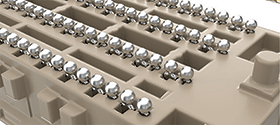

Many factors affect the quality and performance of a connector: pin material, the quality of the stamping, the quality of and choice of surface finish, and the tolerances on the plastic insulator, just to name a few. Beyond the connector, another factor that is crucial to the performance of the connector on the printed circuit board is the quality of the solder joints. David Decker, manager of Samtec’s interconnect processing group (IPG), provides the answer to some common connector questions.
At what peak temperature are most SMT ovens run?
This is probably the most commonly asked question we receive in IPG. The answer is always the same: the peak temperature is the derivative of the solder paste that is used. Samtec’s SMT and SMT-compatible through-hole connectors can handle 260°C without problems. Having said that, most customers run the ovens at significantly lower temperatures, usually between 235 and 245°C, for a lead-free profile.
The reason most of them moderate the temperature is to make sure they are not damaging other heat-sensitive components. So, when asked what the peak temperature for SMT oven processing is, the answer is to usually consult the solder paste manufacturer and see what they recommend for their specific paste.
Will my solder paste work with Samtec connectors?
The answer is probably yes. Samtec has many customers using many different pastes, and the company tries to make all of its connector devices as robust as possible, so that the connector is not the gating item in the processing procedures. So, the chosen solder paste will work with Samtec connectors, with very few exceptions.
Are there any new soldering materials that are gaining interest?
A lot of interest in low-temperature solder paste is currently being experienced. Of course, lead-free technology requires higher temperature processing. The melting point of most SAC lead-free solder pastes is about 217°C, and that’s a significant increase from approximately 183°C for tin-lead solder paste. With the change from tin-lead temperatures to lead-free, many customers are concerned about component warpage, and potential discolouration of heat-sensitive devices and platings.
Solder paste manufacturers are working on other chemistries and technologies to lower the processing temperature. The ones that are most prominent with regard to lowering that melting temperature contain bismuth or indium, which can lower the temperature to 140°C. As always, with every benefit comes a disadvantage, and the primary disadvantage with these low-temperature pastes is brittle, less robust solder joints.
Should I pre-bake my components prior to soldering?
Samtec connectors, and SMT connectors in particular, do not require pre-baking. Per IPC/JEDEC J-STD-020E, Samtec’s connectors do not require pre-baking because the moisture sensitivity level of the connectors is 1. Some customers do pre-bake the connectors, and that is fine as it does not damage them. The need for pre-baking arises due to entrapped water in the component which pre-baking eradicates through evaporation.
If your inventory or manufacturing facility is located in a place with high humidity levels, pre-baking might be more of a factor.
| Tel: | +27 11 425 1400 |
| Email: | [email protected] |
| www: | www.spectrumconcepts.co.za |
| Articles: | More information and articles about Spectrum Concepts |

© Technews Publishing (Pty) Ltd | All Rights Reserved